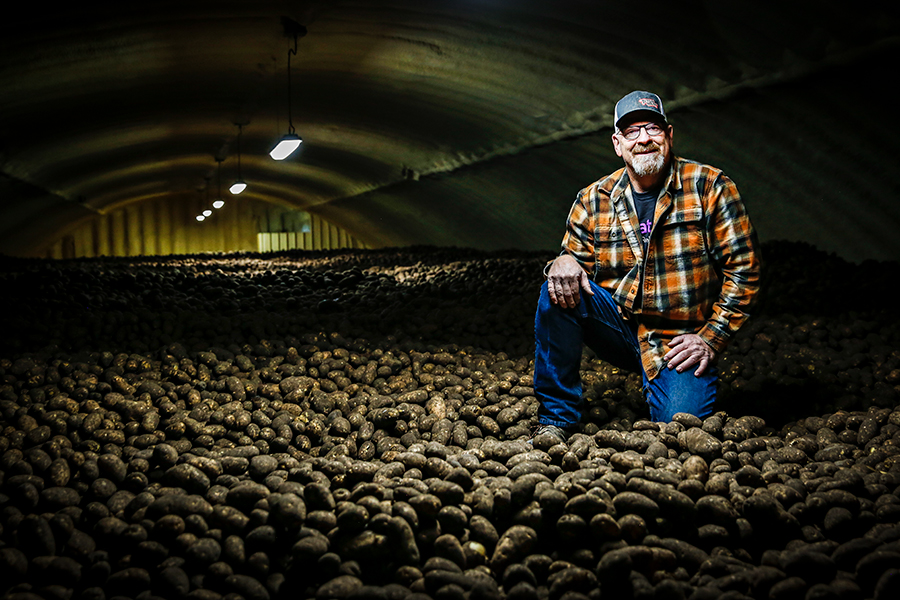A Post-Harvest Halt
After an abundant crop yield in Montana, the pandemic’s broken supply chain and poor market prices have put grains in storage and seed potatoes back in the ground or donated to charities
By Maggie Dresser
When the height of the coronavirus pandemic first took hold last spring, forcing a nationwide shutdown, Flathead Valley seed potato farmer Steve Streich gave away 70,000 pounds of potatoes.
As bars, restaurants, schools and cafeterias closed, frozen French fries began stacking up in freezers and loading docks. Unable to sell to their customers who were not operating, French fry processors immediately called their local potato growers to tell them to pump the brakes.
Once potato farmers slowed down, they only needed a fraction of the seed potatoes they were purchasing from Streich’s 300-acre operation in Creston, Streich Farms.
Since nearly all of Streich’s potatoes are shipped to farmers in Washington, later to become fries in restaurants and cafeterias after they are processed, Streich had nowhere to send his seed potatoes once everything shut down.
“With the pandemic, we had a pretty large shakeup with potatoes in general,” Streich said. “People quit eating in restaurants and food services and schools were shut down.”
A few months ago, millions of pounds of potatoes across Montana were either buried or donated, says Ben Thomas, the director of the Montana Department of Agriculture.
“We have a very strong seed potato industry and the impact on the restaurant scene had a huge impact on food supply,” Thomas said. “We ended up with millions of seed potatoes that were not able to find their market.”
The barley industry was also impacted with bars and restaurants closed, Thomas said. Much of Montana’s barley winds up in Mexico where it’s used to make beer. And many of those contracts were canceled when Mexico’s breweries completely shut down right when the pandemic hit. While the barley is currently in storage, Thomas hopes those contracts will be renewed soon, but for now much of the barley is sitting idle.
Despite the market, Thomas says Montana’s crops did well this year after early spring moisture and limited hail.
“I think the general consensus from a production standpoint is it was a phenomenal year,” he said. “We had really high quality crops and really great growing conditions.”
But with record grain, lentil and chickpea yields, Thomas says that much of it is going into storage with declining market prices.
“Crops were great, prices were not,” Thomas said.
But while larger scale production took a hit from the pandemic, other aspects of agriculture thrived.
With a higher demand for local food, Mandy Gerth of Lower Valley Farm in South Kalispell says she’s seen higher sales this season, especially with Community Supported Agriculture (CSA) sales. Lower Valley had 225 CSAs this year compared to 160 last year.
“It’s been really great,” Gerth said. “It made it so that we could primarily sell anything outside of our CSA directly to customers through our online store … with a larger CSA and online store, we’re going to be sold out probably sooner than normal.”
Last spring, Gerth was awarded a $4,500 state Growth Through Agriculture matching mini-grant, which she largely used to purchase software for their new online store. The store allowed her to accommodate buyers who didn’t attend farmers markets and to set up more organized CSA pickups.
While Gerth had some higher costs this season, she says direct sales will likely cover those costs. The farm didn’t have anything left to sell to restaurants at wholesale this year, so she was able to sell at retail prices directly to customers instead of wholesale to restaurants.
“I’m really proud of our community that showed up week after week and kept buying local,” Gerth said. “I think that this year showed us that we live in a small town and there is a lot of demand for local produce.”
Thomas calls the higher local produce demand “community resilience.” He says rural communities in Montana need to prepare for supply chain disruptions.
“Now, people see the value and they see how it impacts them directly when their local producers are impacted,” Thomas said.
But as a large-scale operation, Streich’s potato farm is experiencing the negative impacts of the broken supply chain.
In the meantime, potato farmers are waiting for market prices and Streich intends to plant, grow and harvest seed potatoes at the same capacity as he did before the pandemic halted sales.
He’s currently sitting on 10 million pounds of potatoes that he planted last May, which he will store until next spring when they are normally sold to potato farmers in Washington.
“We couldn’t be more in the dark,” Streich said. “We are kind of winging it; I think most of the farmers in Montana are. We still don’t know if there’s a home for these potatoes.”
This winter, fry processors and potato farmers will theoretically figure out their needs for the spring and Streich will know if he can sell his seed potatoes.
“We can’t take another shutdown,” Streich added. “People have to be willing to go back and eat at restaurants for the economy to turn around.”